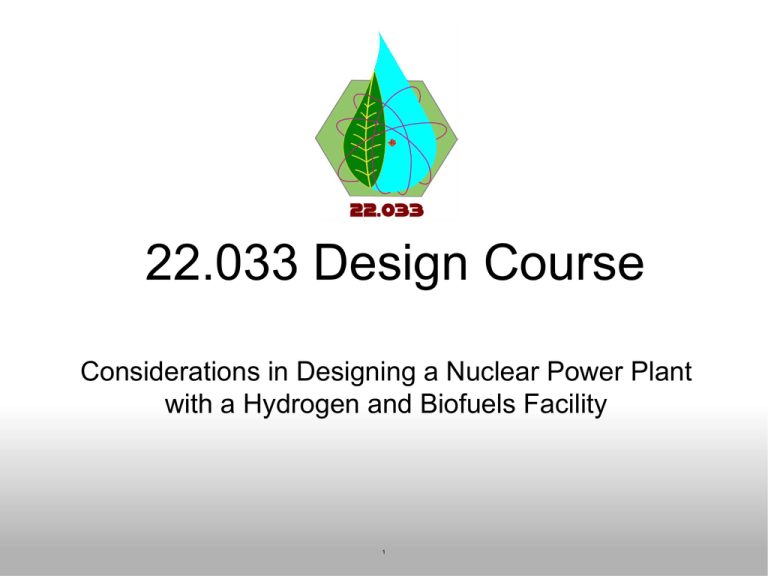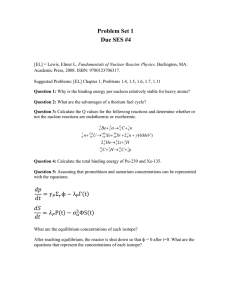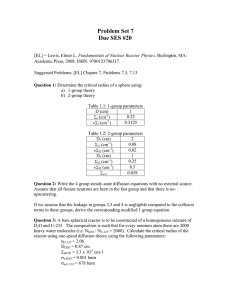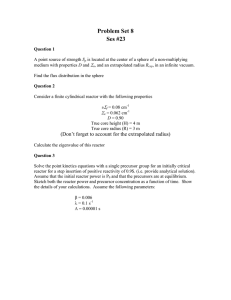
22.033 Design Course
Considerations in Designing a Nuclear Power Plant
with a Hydrogen and Biofuels Facility
1
Why this project?
Green energy policy climate
Oil quickly depleting
Nuclear high energy/electricity output
versus maintenance costs
2
System Layout
3
Reactor Core
4
Outline
1. Goals
2. Overall Design of Reactor Core
3. Radial and Axial Overview of Core
4. Fuel
5. Heat Removal
6. Core Depletion
7. Secondary System
8. Turbines and Heat Exchangers
9. Future Work
5
Reactor Core Goals
• Provide enough electricity and process heat for
hydrogen and biofuels production
• Choose and design a reactor that will operate at
temperatures larger than what is in use
• Produce a unique and innovative reactor
• Final design must be feasible for electrical
production
6
Core Designs Considered
• Supercritical H2O
• CANDU Reactor
• Supercritical CO2
• Molten Salt Reactor
• Traveling Wave Reactor
• Gas-Cooled Fast Reactor
• Sodium-Cooled Fast
Reactor (SFR)
• Pebble Bed Modular
Reactor (PBMR)
• Lead-Cooled Fast
Reactor (LFR) (LBEFR)
• Very High Temperature
Reactor (VHTR)
7
Major Reactor Design Choices
8
Reactor Core Final Design
• Lead-Bismuth Eutectic (LBE) Cooled Fast Reactor
with Supercritical CO2 Secondary Loop
• 3575 MWt (1500 MWe)
Limited by velocity of LBE (2.5 m/s) due to flow
assisted corrosion
Will provide only 1000 MWe to grid, remaining
energy will be used for hydrogen and biofuel
production
9
Core Overview
LBE / CO2 Heat
Exchanger
Thot
Tcold
Thot
RPV
Core
Tcold
Steel
frame
10
Radial Overview of Core
11
Fuel Assembly and Zoning
Axial and Radial Zoning
Pitch/Pin = 1.6
12
Rings
1-4
Rings
5-10
Top
33%
10%
12.5%
Lower
67%
12.5%
15%
Reactor Core Final Design
Outlet Temperature
650° C
Inlet Temperature
484° C
Operating Pressure
Atmospheric
Full Power Operating Mass Flow Rate
143,600 kg/s
Max Fuel Enrichment
15%
Minimum Fuel Enrich
10%
Linear Heat Rate BOL
74.3 kW/m
Fuel Material
UN
13
Reactor Core Final Design
14
Reactor Core Final Design
15
Comparison of UN and UO2
UN
UO2
Thermal
Conductivity
21 W/mK
3-4 W/mK
Melting Point
2800° C
2800° C
Uranium Metal
Density
13.60 g/cm3
9.67 g/cm3
Other
Need to enrich
the nitrogen
Long and safe
operating history
16
Natural Circulation
• Natural circulation appears
sufficient for heat removal at full
power.
• It is likely that pumping power/
extra heat insertion from the
PCM will be needed to maintain
flow during shutdown.
• Further analysis needed to
determine benefits of laminar
vs. turbulent regimes.
17
Plot of mass flux vs. inlet
temperature given an outlet
temperature of 650° C for varying
down channel diameters.
R = 3m. B = 2m. G = 1m
Core Depletion
Zone 1 (kg)
Zone 2 (kg)
Zone 3 (kg)
Total (kg)
BOL Pu
3342
2807
1982
8131
EOL Pu
3375
2849
2044
8268
% change
0.99
1.50
3.13
1.68
BOL U
19356
16254
11476
47086
EOL U
17935
14568
10154
42657
% change
-7.34
-10.37
-11.52
-9.41
BOL MA
516
433
306
1255
EOL MA
423
316
214
953
% change
-18.02
-27.02
-30.07
-24.06
Estimated inventory changes from 2400MWt MIT core after 1800 days
18
Core Reactivity Coefficients
• Estimated again from ELSY, STAR and MIT cores
• Doppler coefficient was found to be -0.111+/-0.03 for MIT core
o Hard spectrum makes this less negative than other LMFBR cores
• Temperature coefficient was found to be +0.131 +/-0.052 for MIT core
o Reactivity insertion at low lead densities not countered by increased
scattering and leakage cross sections at higher temperatures.
• Needs to be explicitly calculated for our core. Use of MgO reflector has
reduced our required enrichment which may change these values
significantly based on work by Driscoll et al.
19
Outlays of the System
• Electric Power
1000 MWe
• Plant Power
500 MWe
• Process Heat
315 MWt
20
Secondary System
21
Secondary System
• Modeled in EES
Temperature and mass flow calculations
Allows for faster optimization
Database provided enthalpy information for S-CO2
• Second turbine added to allow for greater efficiency
• Energy diverted to the Process Heat group does not
significantly affect the secondary system (efficiency
changes from 45.8% to 42.2%)
22
Shell and Tube Heat Exchanger
• Simple design (easy to make, low cost, etc.)
• Larger than PCHE
• Friction effects of LBE reduced
23
Turbines
• Compact due to Brayton Cycle
• Reduces size of turbomachinery
Source: Dostal, V. "A Supercritical Carbon Dioxide Cycle for Next Generation Nuclear Reactors." MIT Sc. D. Thesis, January 2004.
24
Future Work for Core
• Switch to alternate clad material or lower operating
temperature OR both.
• Look at efficiency improvements in secondary system.
• Look at Uranium Carbide as alternate fuel.
• Full depletion and kinematic calculation.
• Determine if decay natural convection possible.
25
Process Heat
26
Outline
1. Goals
2. Heat Exchangers
3. Piping
4. Heat Storage
5. Future Work
27
Process Heat Goals
• Draw heat from the Core to provide steam to the
Hydrogen and Biofuels plants
• Keep the LBE melted during reactor outage
• Design system for operation at high temperatures and
pressures
28
System Layout
29
System Pressure and Temperature Drops
System component
PCHE1
Pressure drop [ kPa ] Temperature change [
]
Hot side
8.043
-316
Cold side
23.749
+405.47
Hot side
9.812
-388
Cold side
13.874
+518.67
Heat storage
1000
-1.5
Piping (30m)
2.047
-0.041
PCHE2
30
C
Heat Exchangers
Thigh= 630° C
Phigh=20 MPa
PCHEs chosen for
their:
•High operating
temperatures
•Small volumes
•High effectiveness
Fig. 1 (pg. 218) from D. Southall and S. J. Dewson, “Innovative Compact Heat Exchangers.” Published in ICAPP
2010, San Diego, CA, June 13-17, 2010. © American Nuclear Society and the authors. All rights reserved. This
content is excluded from our Creative Commons license. For more information, see http://ocw.mit.edu/fairuse.
31
Working Fluid: Helium
Fluid
at 5MPa
[200 C, 700
C]
Carbon Dioxide
(CO2)
Water/Steam
(H2O)
Helium
(He)
Heat Capacity
[J/kg-K]
Viscosity
[Pa-s]
1079.5, 1237.8
2.337 10-5,
4.064 10-5
4476.1, 2351.5
1.35
10-4, 3.678
10-
5188.9, 5190.6
2.74
10-5, 4.533
10-
***data from webbook.nist.gov
32
5
5
PCHE Material: Alloy 617
Reasons for choosing Alloy 617:
•Tensile strength
•Thermal conductivity
•Thermal expansion
•Corrosion resistance
•Ease of manufacturing
•Design life of up to 60 years
PCHEs will operate well below
design stresses at all points in
system
Source: Li, Xiqing., et al. “Alloy 617 for the High Temperature Diffusion-Bonded Compact
Heat Exchangers.” Published in ICAPP 2008, Anaheim, CA, June 8-12, 2008. © American
Nuclear Society and the authors. All rights reserved. This content is excluded from our
Creative Commons license. For more information, see http://ocw.mit.edu/fairuse.
33
Process Heat PCHEs
Parameter
PCHE1
PCHE2
Heat rate/unit
35 MW
26 MW
Number of units
9
12
Total heat rate
315 MW
312 MW
Hot fluid
S-CO2
He
Cold fluid
He
H2O
Channel
configuration
zigzag
straight
location
S-CO2 loop
Hydrogen plant
Total htc
1087.71 W/m2K
735 W/m2K
Volume
8.25 m3
15.6 m3
*HEATRIC's quote for steel $/kg cost used
34
PCHE1: Temperature and Heat Flux Profiles
• Zigzag flow channels
• Counterflow
• Single-phase forced
convection
• No swings in
temperature or heat flux
• S-CO2: turbulent
• He: laminar
35
PCHE1: Temperature and Heat Flux Profiles
• Straight channels
• Counterflow
• Two-phase flow
• Unphysical behavior to the left
of x=0.68m
• Exclude this region
• Both fluids laminar
• Large swings in temperature
and heat flux!
• Design as three separate HXs?
36
Fouling and Design Life
Fouling affects heat rate and pressure drops
PCHE operation up to 500 – 660 hours:
• no change in effectiveness
• 55% increase in pressure drop!
18 month fuel cycle = ~12,960 hours
Solutions:
• Installation of redundant units
• Addition of Cl to fluid streams to reduce biofouling
37
Biofuels Heat Exchanger
•
Recover heat from H2O + H2 and O2 streams at the Hydrogen plant
•
Produce steam at 182°
•
Highly oxidative and reductive environment!
•
Prospective materials: RBSiC and SiSiC
C and 0.1MPa for Biofuels
Courtesy of Acumentrics Corporation. Used with permission.
Ceramic monolith for a38cross flow HX fabrication
Source: Litka, A. F. Presentation slides for “Ceramic/Metallic Heat Exchanger Development.” 9th Annual SECA Workshop, Pittsburgh PA, 2008. (PDF)
Piping Insulation
Adapted from tests and design in “Conceptual Design for a High Temperature Gas Loop Test Facility.” Idaho National Laboratory Report INL/EXT-06-11648, 2006
39
PCM: Lithium Chloride (LiCl)
Property
Value
Melting Point
Δh°
605°
C
470 kJ/kg
fusion
c_p (solid)
1.132 kJ/kg-K
40
Source: http://en.wikipedia.org/wiki/File:Lithium_chloride.jpg (public domain image)
Containment Material: Alloy 20
Nickel-ChromiumMolybdenum alloy
Resistant to chloride
ion corrosion
MP >1380° C
k = 18.15 W/m-K
Min (%)
Max (%)
Nickel
32.5
35.0
Chromium
19.0
21.0
Molybdenum
2.0
3.0
Manganese
0.0
2.0
Copper
3.0
4.0
Silicon
0.0
1.0
Carbon
0.0
0.06
Sulfur
0.0
0.035
Phosphorus
0.0
0.035
Niobium
1.0
none
Iron
0.0
balance
Adapted from: http://www.rolledalloys.com/products/nickel-alloys/alloy-20
41
Storage – Heat Exchanger
42
Storage – Heat Exchanger
Dimension
Value
htank
11.41 m
dPCM
18 m
tPCM
1.13 m
twall
1 cm
Length of tank
20 m
Gap height
43
1 cm
Charging Layout
Charging Time (with 67 MW preheater): 33 days, 12 hours
44
Discharging Layout
45
Emergency Scenarios
Storage: LiCl leak
• Reroute He flow around storage and compressor
Heat Sink
• Average Decay Heat from core process heat 1 hr after shutdown: 5MW
• Maximum temperature change of water : 10°
C
• Volumetric flow rate of seawater : 455 gallons/second
• Ti plate type HX specifically for marine applications
• Outlet diffusers to reach thermal equilibrium quicker/minimize environmental
impact
46
Future Work: Process Heat
• Compare PCHEs with Shell and Tube designs
• Split PCHE2 into multiple stages
• PCHE fouling factors
• Correction factors for determining CHF values for semi-circular channels
• mdot(t) of LBE
• Ensure that ΔT of 10° C is enough to keep LBE molten even for lowest mdot
• Effects of a support system on He flow
• Insulation: steady state and during shutdown
47
Hydrogen Production Plant
48
Outline
1. Engineering Objectives
2. Options for Hydrogen Production
3. UT-3
• Plant Diagram
4. HTSE
• Plant Diagram
• Materials
5. Future Work
49
Engineering Objectives
•
Meet biofuel’s hydrogen requirement
•
Maximize use of process heat
•
Minimize electricity use
•
Zero greenhouse emissions
50
Options for Hydrogen Production
ES: Water Electrolysis
HTSE: High Temperature Steam Electrolysis
SI: Sulfur-Iodine Process
SMR:Steam Methane Reforming
UT-3:University of Tokyo-3
(Ca-Br-Fe Thermochemical Cycle)
51
UT-3 Hydrogen Production
1
Process
• Bromination of calcium oxide, acidity, leads to
material concerns.
1H.Kameyama
and K. Yoshida. Br-ca-fe water decomposition cycles for hydrogen production. Proc. 2nd, WHEC., pages 829–850, 1978.
52
UT-3 Hydrogen Production
Image adapted from: Sakurai, M.
1
Process
"Adiabatic UT-3 Thermochemical Process for Hydrogen Production".
Energy. 2(10), 865-870 (1996).
53
Complications
• Necessary steam temperature could no longer be
provided.
• Electric power required larger than reactor output.
• New hydrogen production design required
54
High Temperature Steam Electrolysis
Image from: U.S. DOE fact sheet for high-temperature electrolysis
55
Solid Oxide Electrolysis Cell (SOEC)
Material Requirements
Electrolyte:
• Dense
• Chemically stable
• High ionic conductivity
• Gas-tight (no H-O recombination)
• Thin (minimize Ohmic resistance)
Electrodes:
• Porous, allows gas transportation
• Similar thermal expansion
coefficient to electrolyte
Courtesy of Elsevier, Inc., http://www.sciencedirect.com. Used with permission.
56
Electrolyte Material
Name
Type
Ionic
Conductivity
(S/cm)
Optimal Temperature
(K)
Comments
YSZ
Stabilized zirconia
0.13
1273
Overall best choice
ScSZ
Stabilized zirconia
0.18
1273
Exorbitant cost
LSGM
Doped LaGaO3
0.17
973
Requires reduced
operating
temperature;
problematic reaction
between LSGM and
Ni
GDC
Ceria-based oxides
0.10
1073
Chemically unstable
SDC
Ceria-based oxide
0.08
1073
Chemically unstable
BaCeO3
Proton-conducting
electrolyte
0.08
1073
Low conductivity
57
HTSE with Regenerative Heating
58
Future Work: Hydrogen Plant
• Determine electrical requirement to better
accuracy.
• Possibly simulate HTSE plant to address
efficiency.
59
Biofuels Production Plant
60
Outline
1. Goals
2. Overall Design of Biofuels Plant
3. Switchgrass
4. Gasification
5. Acid Gas Removal
6. Fischer-Tropsch Reactor
7. Distillation and Refining
8. Final Products and Concluding Thoughts
61
Biofuels Production Plant Goal
• Produce biofuels
• Large scale
• High quality
• Use nuclear power plant
• Process heat
• Electricity
• Hydrogen production plant
62
Biofuels Process Overview
Steam, Heated Air
Gasification
Acid Gas
Removal
Photo of switchgrass by Stephen Ausmus
(USDA), public domain image.
FischerTropsch
Reactor
Distillation &
Refining
Image by MIT OpenCourseWare.
Heat
Hydrogen
63
Choice of Biomass
Feedstock Comparison
Current Cost Energy Density Agriculture Yield
Food
($/ton
(MJ/kg)
(tons/acre)
Source?
Switchgrass
$40
17
11.5
no
Sorghum
$40
17
20
yes
Energy Cane
$34
13
30
no
Sugar Cane
$34
13
17
yes
Corn
$40-50
13.5
3.4
yes
58700 L/ha
no
Algae
64
Switchgrass
Optimal Growing Locations in U.S.
Switchgrass
Growth (Mg/ha)
Map courtesy of Pacific Northwest National Laboratory, operated by Battelle for the U.S. Department of Energy.
65
Switchgrass
Optimal Growing Location in Texas
Map produced by the National Renewable Energy Laboratory for the U.S. Department of Energy.
66
Switchgrass
Growth and Transportation
• Outsource to local farmers job creation
• Quantity: 2903 tons/day
• 85 flat bed trucks/day carrying 33.3 tons each
• 13 closed hopper cars at full capacity
• Pelletize to 1300 kg/m3
67
Biofuels Process Overview
Steam, Heated Air
Gasification
Acid Gas
Removal
Photo of switchgrass by Stephen Ausmus
(USDA), public domain image.
FischerTropsch
Reactor
Distillation &
Refining
Image by MIT OpenCourseWare.
Heat
Hydrogen
68
Gasification
Rentech Silvagas Dual Fluidized Bed Cycle
© ASME. All rights reserved. This content is excluded from our Creative Commons license. For more information, see http://ocw.mit.edu/fairuse.
Gasification
Inputs and Outputs
Mass flow
(kg/s)
Temperature
( C)
Biomass In
24.4
25
Steam In
2.6
182
Air In
11.9
354
Syngas Out
19.9
862
Flue Gas Out
19
916
Composition of Syngas
(by volume):
Other
70
Estimated flow rates calculated using http://chippewa.gtsav.gatech.edu/outreach/workshop/presentations/gfarris.pdf &Twin-Bed Gasification Concepts for Bio-SNG Production (Paisely)
Biofuels Process Overview
Steam, Heated Air
Gasification
Acid Gas
Removal
Photo of switchgrass by Stephen Ausmus
(USDA), public domain image.
Fischer-Tropsch
Reactor
Distillation &
Refining
Image by MIT OpenCourseWare.
Heat
Hydrogen
71
Acid Gas Cleanup Process
Cyclone
Particulate
Removal
(682° C)
Water
Scrubber
(107° C)
Syngas
Cooling
Amine Acid Gas
Removal
LO-CAT Acid
Gas Removal
72
Compressor
(1 bar to
30.7 bar)
Acid Gas Removal Output
Composition of Input to F-T Reactor
After gasification:
19.9 kg/s
After acid gas removal:
14.6 kg/s
Other
Other
73
Biofuels Process Overview
Steam, Heated Air
Gasification
Acid Gas
Removal
Photo of switchgrass by Stephen Ausmus
(USDA), public domain image.
Fischer-Tropsch
Reactor
Distillation &
Refining
Image by MIT OpenCourseWare.
Heat
Hydrogen
74
Fischer-Tropsch Reactor
Slurry Phase Bubble Column Design
• Fe catalyst
• Heat generated: 21.8 MW
Courtesy of Elsevier, Inc., http://www.sciencedirect.com.
Used with permission.
75
Fischer-Tropsch Reactor
Product Selectivity
gasoline
biodiesel
© source unknown. All rights reserved. This content is excluded from our Creative Commons license. For more information, see http://ocw.mit.edu/fairuse.
76
Fischer-Tropsch Reactor
Reactor Outputs
Carbon Content
Product
Classification
Mass Flow (kg/s)
C1 - C5
Light Gas
2.02
C5 - C12
Naphtha
(Gasoline)
5.09
C12 - C20
Distillate
(Biodiesel)
2.65
C20+
Heavy wax
1.46
77
Biofuels Process Overview
Steam, Heated Air
Gasification
Acid Gas
Removal
Photo of switchgrass by Stephen Ausmus
(USDA), public domain image.
Fischer-Tropsch
Reactor
Distillation &
Refining
Image by MIT OpenCourseWare.
Heat
Hydrogen
78
Distillation
79
Fraction
Boiling Point
( C)
Light Gases
< 40
Light
Naptha
30-90
Heavy
Naptha
90-200
Distillate
200-300
Heavy Wax
300-350
Refining
Hydrogen Inputs
© ACS. All rights reserved. This content is excluded from our Creative Commons license. For more information, see http://ocw.mit.edu/fairuse.
80
Biofuels Process Overview
Steam, Heated Air
Gasification
Acid Gas
Removal
Photo of switchgrass by Stephen Ausmus
(USDA), public domain image.
Fischer-Tropsch
Reactor
Distillation &
Refining
Image by MIT OpenCourseWare.
Heat
Hydrogen
81
Final Products
Product Classification
Mass Flow (kg/s) Mass Flow (barrels/day)
Light Gas
2.02
---
Diesel
2.87
1874
Gasoline
6.33
4780
Total Diesel and Gasoline
11.22
6654
• Expected revenue from: > $1.7 million/day
• Assuming 15 gal/tank, this amount of gasoline and diesel
can fill over 18,500 cars/day
• Compare to U.S. 2011 demand of 9.12 million barrels/day
82
http://pascagoula.chevron.com/Files/pascagoula/Misc/2010%20Fact%20Sheet.pdf
Carbon Sequestration
CO2 management
• Options:
• Recycle
• Sell
• Underground storage
• Deep ocean dissolution
• CO2 liquifies at 300kg/m3
• Compress to 20 MPa with inline integrally geared
compressor and DDHF
multistage barrel pump
© General Electric Company. All rights reserved. This content is excluded from our
Creative Commons license. For more information, see http://ocw.mit.edu/fairuse.
83
Looking Forward
Public domain image
84
Future Work and Economics
• Potential improvements
- scale up
- use oxygen from H2 plant in gasification step
-recycle flue gas, H2S, CO2 wastes
• Jobs generated: farmers, drivers, plant workers
• Total daily profit: $1.4 million/day
• Total profit selling only electricity: $0.83 million/day
85
Concluding Thoughts
86
Implications
• This facility design can feasibly produce green
electricity, biodiesel, and biogasoline
• Minimal carbon emissions
• Nuclear reactor produces 1000 MWe to grid and
powers hydrogen and biofuel plants
• Biofuels produces enough alternative fuels for
18,500 cars/day
87
Acknowledgments
• Dr. Short
• Tyrell Arment
• Koroush Shirvan
• Professor Golay
• Professor Forsberg
• Professor Driscoll
• Professor Todreas
88
Questions & Discussion
89
MIT OpenCourseWare
http://ocw.mit.edu
22.033 / 22.33 Nuclear Systems Design Project
Fall 2011
For information about citing these materials or our Terms of Use, visit: http://ocw.mit.edu/terms.



